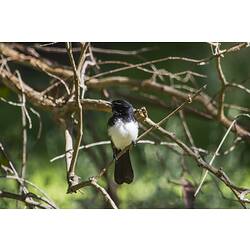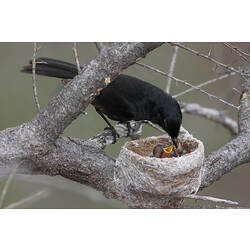General Description
Black with white underparts and white eyebrows. They spread their tail out like a fan and continually wag it from side to side. The bill to tail length is up to 22 cm.
Biology
Willie Wagtails are usually found singly or in pairs. They can form winter flocks mixed with other species. They catch insects on the ground or in flight and will follow or perch on livestock, catching insects disturbed by their movements. They sometimes eat small lizards. They are highly territorial and call repeatedly at night during the breeding season to advertise their territory. Their nest is a neat, shallow woven cup constructed from grasses lined with soft grasses, hair, feathers or fur plucked directly from animals. The outside is covered in spider webs. Nests are built on a horizontal branch and are re-used over multiple years. A breeding pair can raise up to four clutches of eggs in a season. Young birds remain with their parents until the eggs from the successive clutch hatch. They are Australia's largest fantail.
Distribution
Mainland Australia and offshore islands (except Tasmania). Also New Guinea, Indonesia, Solomon Islands and the Bismarck Archipelago.
Habitat
Most open areas, especially forests and woodlands. Common in urban areas.
More Information
-
Animal Type
-
Animal SubType
-
Brief Id
A black and white bird with a fanned tail.
-
Colours
Black, White
-
Maximum Size
22 cm
-
Habitats
Wetland, Urban, DryForest, WetForest, Woodland, Mallee, Grassland, Coastal shrub
-
Diet
Insects
-
Endemicity
-
Commercial
No
-
Conservation Statuses
CITES: Not listed, FFG Threatened List: Not listed, EPBC Act 1999: Not listed, IUCN Red List: Least Concern
-
Taxon Name
-
Common Name
Willie Wagtail
-
Kingdom
-
Phylum
-
Subphylum
-
Class
-
Order
-
Family
-
Genus
-
Species Name
leucophrys












